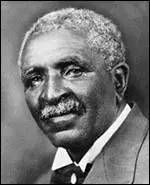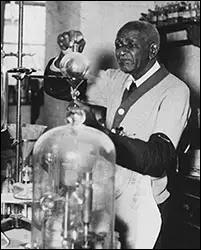George Washington Carver
 George Washington Carver was born in 1860 in Diamond Grove, Missouri and despite early difficulties would rise to become one of the most celebrated and respected scientists in United States history. His important discoveries and methods enabled farmers through the south and midwest to become profitable and prosperous.
George Washington Carver was born in 1860 in Diamond Grove, Missouri and despite early difficulties would rise to become one of the most celebrated and respected scientists in United States history. His important discoveries and methods enabled farmers through the south and midwest to become profitable and prosperous.
George was born the sickly child of two slaves and would remain frail for most of his childhood. One night a band of raiders attacked his family and stole George and his mother. Days later, George was found unharmed by neighbors and was traded back to his owners in exchange for a racehorse. Because of his frailty, George was not suited for work in the fields but he did possess a great interest in plants and was very eager to learn more about them.
In 1887 Carver was accepted into Simpson College in Indianola, Iowa where he became well respected for his artistic talent (in later days his art would be included in the spectacular World’s Columbian Exposition Art Exhibit.) Carver’s interests, however, lay more in science and he transferred from Simpson to Iowa Agricultural College (which is now known as Iowa State University.) He distinguished himself so much that upon graduation he was offered a position on the school’s faculty, the first Black accorded the honor. Carver was allowed great freedom in working in agriculture and botany in the University’s greenhouses. In 1895, Carver co-authored a series of papers on the prevention and cures for fungus diseases affecting cherry plants.
In 1896 he received his master’s degree in agriculture and in 1897 discovered two funguses that would be named after him. At this point, the most pivotal moment of his life arose – he was summoned by Booker T. Washington to teach at Tuskegee Normal and Industrial Institute. He was appointed director of agriculture and quickly set out to completely correct its wretched state. He was given a 20 acre shabby piece of land and along with his students planted peas on it. Like all legumes, the peas had nitrogen-fixing bacteria on their roots which took nitrogen from the air and converted it into nitrates which then worked to fertilize the soil. The depleted soil quickly became rich and fertile, so much so that he was able to grow 500 pounds of cotton on each acre of land he worked on.
Carver soon instructed nearby farmers on his methods of improving the soil and taught them how to rotate their crops to promote a better quality of soil. Most of the staple crops of the south (tobacco and cotton) stole nutrients from the soil, but these nutrients could be returned to the soil by planting legumes. Thus, in order to improve the soil, Carver instructed the farmers to plant peanuts, which could be harvested easily and fed to livestock. The farmers were ecstatic with the tremendous quality of cotton and tobacco they grew later but quickly grew angry because the amount of peanuts they harvested was too plentiful and began to rot in overflowing warehouses. Within a week, Carver had experimented with and devised dozens of uses for the peanut, including milk and cheese. In later years he would produce more than 300 products that could be developed from the lowly peanut, including ink, facial cream, shampoo and soap.
Suddenly, the same farmers who cursed him now found that a new industry had sprung up that could use their surplus peanuts. Next, Carver looked at ways of utilizing the sweet potato and was able to develop more than 115 products from it including flour, starch and synthetic rubber (the United States Army utilized many of his products during World War I.)
 He was elected a Fellow of the Royal Society of Arts, Manufacturers and Commerce of Britain in 1916, the Spingarn Medal from the National Association for the Advancement of Colored People in 1923, and in 1939 was awarded the Theodore Roosevelt Medal for “distinguished research in agricultural chemistry.” He was appointed to various boards and committees by the United States Department of Agriculture and was named Man of the Year in 1940 by the International Federation of Architects, Engineers, Chemists and Technicians. Finally, he received honorary Doctor of Science degrees from Simpson College as well as the University of Rochester.
He was elected a Fellow of the Royal Society of Arts, Manufacturers and Commerce of Britain in 1916, the Spingarn Medal from the National Association for the Advancement of Colored People in 1923, and in 1939 was awarded the Theodore Roosevelt Medal for “distinguished research in agricultural chemistry.” He was appointed to various boards and committees by the United States Department of Agriculture and was named Man of the Year in 1940 by the International Federation of Architects, Engineers, Chemists and Technicians. Finally, he received honorary Doctor of Science degrees from Simpson College as well as the University of Rochester.
No comments:
Post a Comment
Welcome! If you Like what you see, please comment, share thoughts and Visit our other Links! We will Love to see your comments here!!! Always write nice please! Thank you! Subscribe too please!!